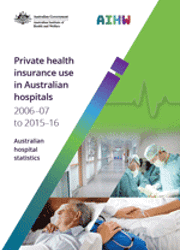Summary
Australians who have private health insurance can use that insurance to completely or partially fund their stay in public or private hospitals.
This report presents information on admitted patient separations (hospitalisations) that were completely or partially funded by private health insurance in Australia’s public and private hospitals over the past 10 years. It includes comparisons of private health insurance-funded hospitalisations with hospitalisations for public patients and hospitalisations for patients funded by other sources. Also included are comparisons of funding for hospitalisations in public and private hospitals. As not all services are available at all hospitals, particularly in regional and remote areas, sometimes the type of care required may determine which type of hospital is used.
This summary provides examples of the statistics and information available in this report.
Private health insurance coverage
Almost half of the Australian population have private health insurance hospital cover. The proportion increased from 43.3% (at 30 June 2006) to 47.3% (at 30 June 2015) and then fell to 46.0% at 30 June 2017.
In 2016, people aged 60 to 64 had the highest rate of hospital insurance coverage (57.1%), and people aged 25 to 29 had the lowest rate (29.4%).
Private health insurance hospitalisations between 2006–07 and 2015–16
Private health insurance-funded hospitalisations in public and private hospitals combined, increased from 2.7 million in 2006–07 (36% of all hospitalisations) to 4.5 million in 2015–16 (42% of all hospitalisations), or an increase of 5.6% on average each year. This compares with a yearly average increase of 3.8% for all hospitalisations.
In 2006–07, about 1 in 7 (14.0%) private health insurance-funded hospitalisations occurred in public hospitals, and this increased to about 1 in 5 (19.5%) in 2015–16. Changes for states and territories during this period include:
- for New South Wales the proportion increased from 22.2% to 25.8%
- for Victoria the proportion increased from 12.8% to 19.4%
- for Queensland the proportion increased from 4.8% to 15.4%
- for Western Australia, the proportion decreased from 10.8% in 2006–07 to 9.3% in 2011–12, and increased to 10.8% in 2015–16
- for South Australia, the proportion decreased from 13.6% in 2006–07 to 9.9% in 2011–12, and increased to 11.6% in 2015–16.
For Tasmania, the Australian Capital Territory and the Northern Territory combined, the proportion increased from 20.3% to 23.5% between 2006–07 and 2015–16.
Preliminary material: Contents; Acknowledgments; Abbreviations; Symbols
-
Introduction
- What’s in this report?
- What data are drawn on for this report?
- Terms and methods used in this report
- Where to go for more information
- Other reporting/suggested reading
-
Who has private health insurance in Australia?
-
Funding sources for separations in Australian hospitals, 2006–07 to 2015–16
-
Funding sources for separations in Australian hospitals, 2015–16
-
Broad categories of service, 2015–16
-
Childbirth
-
Surgical care
-
Medical care
-
Other acute care
-
1Mental health care
-
Subacute and non-acute care
Appendix A: Data Quality Statement summary
Appendix B: Technical notes
End matter: Glossary; References; List of tables; List of figures; Related publications



